|
|
|
Sort Order |
|
|
|
Items / Page
|
|
|
|
|
|
|
| Srl | Item |
| 1 |
ID:
082999
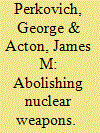

|
|
|
|
|
| Publication |
London, Routledge, 2008.
|
| Description |
130p.
|
| Series |
Adelphi Paper; 396
|
| Standard Number |
9780415465830
|
|
|
|
|
|
|
|
|
|
|
|
Copies: C:1/I:0,R:0,Q:0
Circulation
| Accession# | Call# | Current Location | Status | Policy | Location |
| 053755 | 355.0217/PER 053755 | Main | On Shelf | General | |
|
|
|
|
| 2 |
ID:
079568
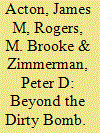

|
|
|
| 3 |
ID:
113119
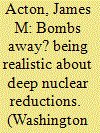

|
|
|
| 4 |
ID:
172899
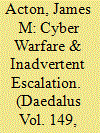

|
|
|
|
|
| Summary/Abstract |
The advent of cyber warfare exacerbates the risk of inadvertent nuclear escalation in a conventional conflict. In theory, cyber espionage and cyberattacks could enhance one state's ability to undermine another's nuclear deterrent. Regardless of how effective such operations might prove in practice, fear of them could generate escalatory “use-‘em-before-you-lose-‘em” pressures. Additionally, cyber threats could create three qualitatively new mechanisms by which a nuclear-armed state might incorrectly conclude that its nuclear deterrent was under attack. First, cyber espionage could be mistaken for a cyberattack. Second, malware could accidentally spread from systems that supported non-nuclear operations to nuclear-related systems. Third, an operation carried out by a third party could be misattributed by one state in a bilateral confrontation to its opponent. Two approaches to risk reduction are potentially viable in the short term: unilateral restraint in conducting potentially escalatory cyber operations, and bilateral or multilateral behavioral norms.
|
|
|
|
|
|
|
|
|
|
|
|
|
|
|
|
| 5 |
ID:
103814
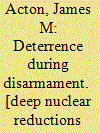

|
|
|
|
|
| Publication |
London, International Institute for Strategic Studies, 2011.
|
| Description |
128p.
|
| Series |
Adelphi Paper, 417
|
| Standard Number |
9780415681827
|
|
|
|
|
|
|
|
|
|
|
|
Copies: C:1/I:0,R:0,Q:0
Circulation
| Accession# | Call# | Current Location | Status | Policy | Location |
| 055904 | 355.825119/ACT 055904 | Main | On Shelf | General | |
|
|
|
|
| 6 |
ID:
161211
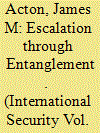

|
|
|
|
|
| Summary/Abstract |
Nonnuclear weapons are increasingly able to threaten dual-use command, control, communication, and intelligence assets that are spaced based or distant from probable theaters of conflict. This form of “entanglement” between nuclear and nonnuclear capabilities creates the potential for Chinese or Russian nonnuclear strikes against the United States or U.S. strikes against either China or Russia to spark inadvertent nuclear escalation. Escalation pressures could be generated through crisis instability or through one of two newly identified mechanisms: “misinterpreted warning” or the “damage-limitation window.” The vulnerability of dual-use U.S. early-warning assets provides a concrete demonstration of the risks. These risks would be serious for two reasons. First, in a conventional conflict against the United States, China or Russia would have strong incentives to launch kinetic strikes on U.S. early-warning assets. Second, even limited strikes could undermine the United States' ability to monitor nuclear attacks by the adversary. Moreover, cyber interference with dual-use early-warning assets would create the additional danger of the target's misinterpreting cyber espionage as a destructive attack. Today, the only feasible starting point for efforts to reduce the escalation risks created by entanglement would be unilateral measures—in particular, organizational reform to ensure that those risks received adequate consideration in war planning, acquisition decisions, and crisis decisionmaking. Over the longer term, unilateral measures might pave the way for more challenging cooperative measures, such as agreed restrictions on threatening behavior.
|
|
|
|
|
|
|
|
|
|
|
|
|
|
|
|
| 7 |
ID:
142266
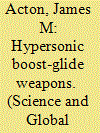

|
|
|
|
|
| Summary/Abstract |
The United States, Russia and China are developing hypersonic boost-glide vehicles. A simple model of their trajectory is developed by assuming that the vehicle does not oscillate during the transition to equilibrium gliding. This model is used to analyze U.S. Department of Defense data on test flights for the Hypersonic Technology Vehicle-2. This glider's lift-to-drag ratio—a key performance parameter—is estimated to be 2.6. The model is also used to calculate the tactical warning time that a boost-glide attack would afford an adversary. Other aspects of boost-glide weapons’ military effectiveness are explored. Approximate calculations suggest that, compared to existing non-nuclear weapons, boost-glide weapons could penetrate more deeply but would be less effective at destroying silos. The distance at which a boost-glide weapon armed with a particle dispersion warhead could destroy a mobile missile is also calculated; it is expected to be significantly larger than for an explosive warhead.
|
|
|
|
|
|
|
|
|
|
|
|
|
|
|
|
| 8 |
ID:
131603
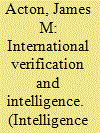

|
|
|
|
|
| Publication |
2014.
|
| Summary/Abstract |
Both national intelligence agencies (NIAs) and international verification organizations (IVOs) attempt to assess compliance with arms control treaties. Their strengths and weaknesses are complementary. Because IVOs are seen as legitimate, they are able to conduct on-site inspections to verify declared activities and to confirm or disprove allegations of clandestine cheating. NIAs are more flexible and have a greater ability to uncover preliminary evidence of clandestine activities on which further investigations can be based. Such investigations require NIAs to share intelligence with IVOs. While this kind of intelligence sharing is generally permitted by arms control agreements, it is controversial. Nonetheless, it appears to have become more common in recent years, particularly during the International Atomic Energy Agency's investigation of Iran's nuclear program. While intelligence sharing creates risks for both IVOs and NIAs, it is ultimately critical to the effective verification of arms control agreements and steps can and should be taken to ensure it becomes more common and less controversial.
|
|
|
|
|
|
|
|
|
|
|
|
|
|
|
|
| 9 |
ID:
083633
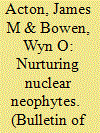

|
|
|
| 10 |
ID:
086171
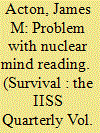

|
|
|
|
|
| Publication |
2009.
|
| Summary/Abstract |
The basic technologies that underlie nuclear power were first developed during the Second World War by the United States for purely military purposes. Since then, extensive civilian research and the use of nuclear technologies for peaceful ends has not erased this military heritage. Almost all nuclear technology in use around the world today is 'dual use', able to contribute to the production of fuel for nuclear reactors or the explosive components of nuclear weapons. For this reason, there is serious concern that supposedly peaceful nuclear programmes are being used for, or could become, cover for the development of nuclear weapons.
|
|
|
|
|
|
|
|
|
|
|
|
|
|
|
|
| 11 |
ID:
143301
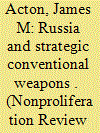

|
|
|
|
|
| Summary/Abstract |
Russian political leaders and military strategists are growing increasingly concerned about “strategic conventional weapons”—a broad category that appears to include all non-nuclear, high-precision, standoff weapons—and about long-range, hypersonic weapons, in particular. These concerns are complex and multifaceted (and, in some cases, contradictory), but chief among them are the beliefs that strategic conventional weapons could prove decisive in a major conflict and that Russia is lagging behind in their development. US programs to develop and acquire such weapons—namely, the Conventional Prompt Global Strike program—are of great concern to Russian strategists, who argue both that the United States seeks such weapons for potential use against Russia—its nuclear forces, in particular—and because strategic conventional weapons are more “usable” than nuclear weapons. Asymmetric responses by Russia include increased reliance on tactical nuclear weapons, efforts to enhance the survivability of its nuclear forces, and investments in air and missile defenses. There is also strong—but not completely conclusive evidence—that Russia is responding symmetrically by attempting to develop a long-range, conventionally armed boost-glide weapon.
|
|
|
|
|
|
|
|
|
|
|
|
|
|
|
|
| 12 |
ID:
079629
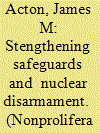

|
|
|
|
|
| Publication |
2007.
|
| Summary/Abstract |
The nuclear weapon states see International Atomic Energy Agency (IAEA) safeguards as an important means of preventing proliferation and, therefore, of enhancing their own security. Many non-nuclear weapon states are, however, reluctant to accept the IAEA's Additional Protocol or even consider developing new safeguards instruments. They frequently claim that this is because the nuclear weapon states have failed to make sufficient progress toward their disarmament pledge, as embodied in Article VI of the Treaty on the Non-Proliferation of Nuclear Weapons (NPT). This viewpoint discusses whether the nuclear weapon states should adopt a strategy of working toward disarmament as a means of strengthening safeguards. Three questions are explored. First, are the weapon states right to see safeguards as an effective means of preventing proliferation? Second, will progress by the nuclear weapon states toward disarmament strengthen the safeguards regime? Third, what does that actually involve? There is a "political" connection between safeguards and disarmament. The weapon states should seriously consider exploiting that connection, with the aims of encouraging the adoption of additional safeguards by some states and putting pressure on others that use the slow pace of disarmament as an excuse for recalcitrance
|
|
|
|
|
|
|
|
|
|
|
|
|
|
|
|
|
|
|
|
|